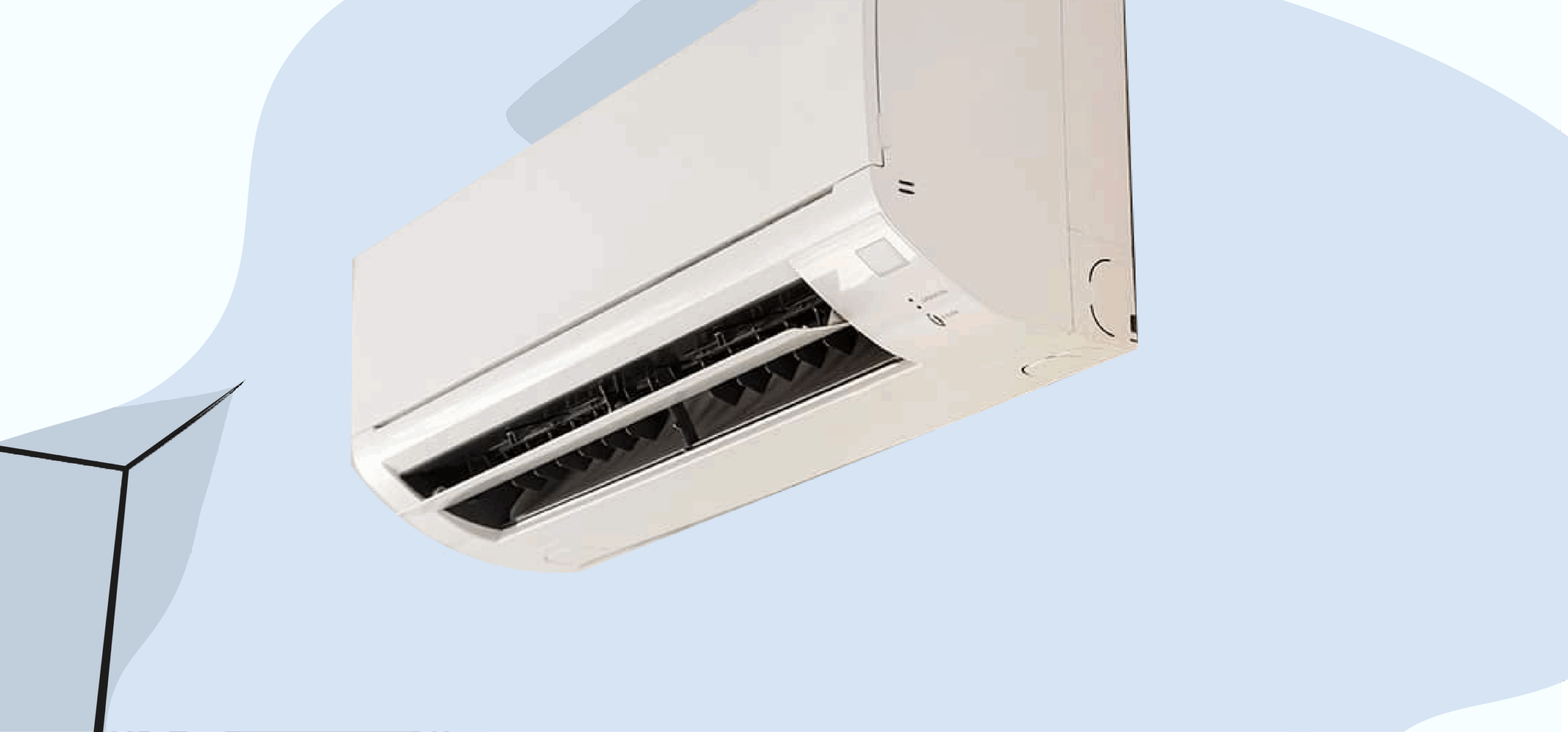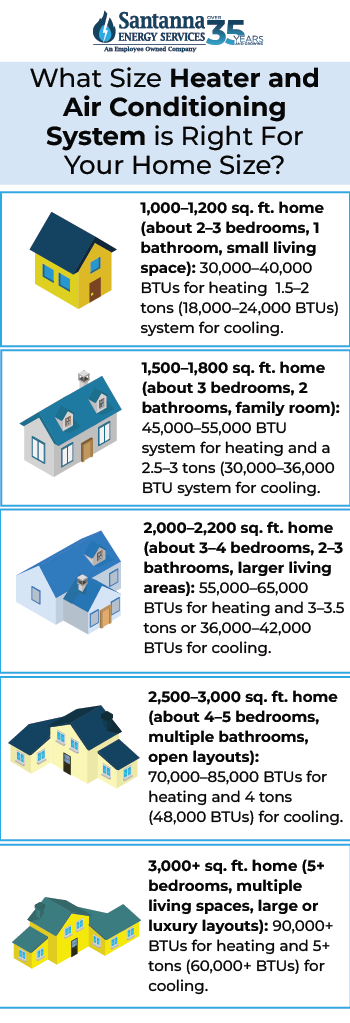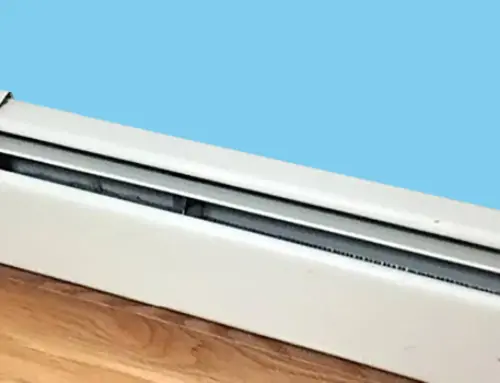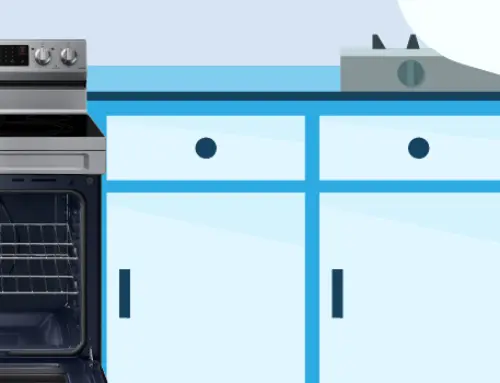How to Size a Heating and Air Conditioning System
by Tyler Castle
15.1 min read

When you're making decisions about home comfort, few choices matter more than how to size a heating and air conditioning system. Get it wrong, and you'll feel the impact every day.
Sizing isn't just about square footage. As energy experts with 35 years as an energy supplier, we know just how important the right size unit can make a difference in terms of comfort and the cost of your bills.
If this feels overwhelming, don't worry, we've got you. In this guide, we'll show you the process, what really matters, and explain how the right system size connects directly to your comfort, your budget, and your energy bill.
Key Points of This Article:
- Proper HVAC sizing is essential for comfort and efficiency—using a system that’s too large or too small can lead to higher energy bills, poor humidity control, and uneven temperatures.
- The most accurate way to determine the right system size is through a Manual J load calculation, which considers factors like insulation, climate, windows, layout, and occupancy.
- Square footage estimates offer a quick sizing method, but they don’t account for critical variables like home age, insulation quality, or sun exposure, making them less reliable.
- Choosing the correct size system can save homeowners hundreds of dollars annually, while also extending the lifespan of the HVAC unit and improving overall home comfort.
What's the Typical Size of a HVAC Unit?
For most homes, the typical size of a heating and air conditioning system falls in the middle range, but the exact size depends on your home's square footage, insulation, climate, and layout.
On average, a furnace for a 1,500–2,000 sq. ft. home is usually between 45,000 and 60,000 BTUs, while many central air conditioners for the same size home are between 2.5 and 3.5 tons (about 30,000–42,000 BTUs of cooling per hour).
Smaller homes may need less, and larger or less insulated homes may require more. For example, a 2,000 sq. ft. well-insulated home in Ohio might only need a 2.5-ton AC, while an older home of the same size in Michigan might need closer to 3.5 tons.
These "typical" ranges give a starting point, but the most accurate way to know the right size for your home is through a professional Manual J load calculation. But stay tuned! We'll help you do this in a few sections.
Factors That Affect the Size of Your Heating and Air Conditioning System
When you're figuring out what size heating or cooling system your home needs, it's not just about square footage. Every home is different, and several features can change the amount of power your system requires:
- Climate: If you live in a colder state like Pennsylvania or Michigan, you'll need more heating power to handle long winters. In Ohio or Illinois, you may need stronger cooling to manage hot, humid summers.
- Insulation & Air Leaks: Well-insulated walls, attics, and windows help your home hold in heat during winter and keep it out during summer. If your home is drafty or older, your system will need to work harder and may need to be larger.
- Home Layout & Design: High ceilings mean more air volume to condition. Open floor plans require more power to keep big spaces comfortable. Additions, basements, or sunrooms also increase demand.
- Age of the Home: Older homes often have less insulation and less efficient windows, which increases heating and cooling needs. Newer or updated homes typically require smaller systems because they're built to be more energy efficient.
- Windows & Sun Exposure: Large or older windows let in more heat during summer and lose more heat during winter. Homes with energy-efficient windows usually need smaller systems.
- Number of People & Appliances: More people living in the home, frequent cooking, and lots of electronics all add heat, which increases cooling needs in the summer.
How to Size a Heating and Air Conditioning System
Sizing a heating or air conditioning system isn't about buying the biggest unit you can afford or relying on a simple "rule of thumb." It's about finding the right fit for your home so you stay comfortable year-round without wasting energy or money. Here's how to correctly size your unit:
1. Manual J Load Calculation (Most Accurate)
The Manual J Load Calculation is the most precise professional standard recommended by the Air Conditioning Contractors of America (ACCA). A Manual J calculation measures how much heat your home gains in summer and loses in winter and you can use this to find the right size heating and air conditioning unit.
This calculation looks at all the factors from square footage of your home, your climate zone, type and quality of insulation, number and size of windows, your ceiling height and layout (open floor plan vs. smaller rooms), and the occupancy and use of your household appliances.
The result is a "custom fit" system size for your home, much more reliable than a one-size-fits-all rule.
To calculate a Manual J load, a homeowner or technician must gather specific data about the house's construction and site. This information is then input into specialized HVAC software that uses the detailed inputs to perform an accurate load calculation, rather than a simple rule-of-thumb estimation, to determine the proper size for the home's heating and cooling system.
Here's an example of using the Manual J Load Calculation:
Imagine a 2,000-square-foot two-story home in central Ohio with moderate insulation, nine energy-efficient windows, and an open main floor.
A technician measures the window area, ceiling height, orientation to the sun, occupancy (four people), and the output of heat-generating appliances.
After entering these details into Manual J software, the calculation might show a heating load of about 58,000 BTUs.
If the same house had older single-pane windows and less attic insulation, the result could rise closer to 70,000 BTUs for heating and 42,000 BTUs for cooling, illustrating how the Manual J method adjusts system size to the home's unique characteristics.
For the MOST accurate and refined number, you'll want to contact a professional for a fine-tuned estimate.
An accurate estimate can shift the number of BTU's you'll need for your heating and cooling system by about 20 percent. That custom fit ensures you're not over- or under-sizing your system.
2. Square Footage Estimate (Quick Method)
The square footage method is a simple way to estimate the size of heating or cooling system you might need based on your home's total floor area. It's not as precise as a Manual J calculation, but it gives homeowners a starting point:
Here's a general formula for how the basic estimate is done:
- To size your heating and air conditioning system, first, you'll want to find your home's square footage. Be sure to only count the areas you heat or cool. If you're not cooling room like basements or garages, don't factor them into your calculation.
- Once you have your square-foot estimation, it's time to calculate your heating estimate. To do this, multiply by 20–35 BTUs per square foot. If you have excellent insulation and experience mild winter, we recommend you use the lower half of this range (between 20-35 BTUs) in your calculation and if you have an older home calculate 30-35 BTUs. The older the home, the more likely you'll need more power to heat it.
For a cooling estimate, we recommend you multiply your square-footage by 20 BTUs per square-foot. Then divide by 12,000 to get tons (since 1 ton = 12,000 BTUs). Note that is step is only necessary if you're looking to size your air conditioning unit.
For example, a 2,000 square-foot home in the Midwest will come out to 60,000 BTUs for heating (2,000 × 30) and about 3.3 tons 2,000 × 20 = 40,000 BTUs divided by 12,000) for their cooling needs.
Keep in mind that this method doesn't account for insulation, windows, layout, or occupancy, so two homes with the same square footage may need very different systems.
Looking to skip math and the appointment? Reference our size chart to help yourself out:
Heating System Size Chart
| Home Size (sq. ft.) | Approx. BTUs Needed (Heating) | Notes |
| 1,000–1,200 sq. ft. | 30,000–40,000 BTUs | Smaller homes, apartments |
| 1,500–1,800 sq. ft. | 45,000–55,000 BTUs | Typical Midwest family home |
| 2,000–2,200 sq. ft. | 55,000–65,000 BTUs | Average newer suburban home |
| 2,500–3,000 sq. ft. | 70,000–85,000 BTUs | Larger homes, open layouts |
| 3,000+ sq. ft. | 90,000+ BTUs | Large/luxury homes |
Average Midwest guideline: 20–35 BTUs per square foot depending on climate and insulation.
Air Conditioning Size Chart
| Home Size (sq. ft.) | Approx. Cooling Capacity | In Tons | Notes |
| 1,000–1,200 sq. ft. | 18,000–24,000 BTUs | 1.5–2 tons | Smaller homes, apartments |
| 1,500–1,800 sq. ft. | 30,000–36,000 BTUs | 2.5–3 tons | Typical Midwest family home |
| 2,000–2,200 sq. ft. | 36,000–42,000 BTUs | 3–3.5 tons | Average newer suburban home |
| 2,500–3,000 sq. ft. | 48,000 BTUs | 4 tons | Larger homes, open layouts |
| 3,000+ sq. ft. | 60,000+ BTUs | 5+ tons |
Large/luxury homes |
Average guideline: 20 BTUs per square foot, or 1 ton of cooling per 500–600 sq. ft.
Many homeowners make the mistake of guessing or relying only on square footage. But every home is unique. Use square footage as a rough guide, but always confirm with a professional using a Manual J calculation. It’s the best way to make sure your heating and air conditioning system keeps you comfortable, saves on energy bills, and lasts longer.
How the Wrong Size System Affects Your Utility Bills
Heating and cooling make up nearly half of your energy bill, so the wrong size system can quietly add up month after month.
If your system is too big, it turns on and off constantly, wasting energy and leaving your home damp and uncomfortable.
If it’s too small, it runs nonstop, drives up bills, and still struggles to keep you warm or cool.
The right size system runs efficiently, keeps temperatures steady, controls humidity, and helps keep your utility costs predictable.
For a household with a $200 monthly energy bill, the wrong size system could mean an extra $40–$60 every month or up to $500–$700 a year wasted.
What Size Air Conditioning Unit Do I Need?
Looking to skip the math? We get it! We’ve done the work for you. Cooling systems are sized differently from heating. An air conditioner’s capacity is measured in tons, with 1 ton equal to 12,000 BTUs of cooling per hour. This number tells you how much heat the system can pull out of your home each hour.
The size of your heating and cooling air conditioning system really matters. If your air conditioning unit is too small, it will run nonstop and still struggle to cool your home on hot days. If it’s too large, it will blast cold air quickly but shut off before it can remove humidity.
That leaves your home feeling clammy while your bills rise from inefficient cycling. A general rule of thumb for the correct size of your air conditioning unit is about 20 BTUs of cooling per square foot.
While every home is unique, most single-family homes in the Midwest fall between 1,500 and 2,200 square-feet. That means the “typical” air condition system sizes you’ll need are:
- 45,000–65,000 BTUs for heating systems (furnaces/boilers)
- 30,000–42,000 BTUs for air conditioning systems
These ranges cover the majority of homes, though the exact number depends on insulation, layout, and how old the house is.
Examples of Sizing Your Air Conditioning Unit
To help put all this information into perspective, we’ve put together a few here are a few real-world scenarios and what their ideal air conditioning unit size would be for different housing units. Here’s what you could expect:
A well-Insulated Suburban Home (2,000 sq. ft. in Ohio)
This could be a 1990s two-story colonial with newer double-pane windows, a sealed attic, and plenty of shade trees. Because heat doesn’t escape or enter as quickly, the home keeps cool efficiently. With updated windows and attic insulation, this home may only need about 55,000 BTUs for heating and a 3-ton AC (36,000 BTUs) for cooling.
Older Drafty Home (2,000 sq. ft. in Michigan)
Think of a 1920s bungalow with original single-pane windows, little wall insulation, and a basement that seeps humidity. Hot air infiltrates in summer and warm air escapes in winter, forcing the system to work harder. This home might need closer to 65,000 BTUs for heating and a 3.5-ton AC (42,000 BTUs).
Smaller City Home (1,400 sq. ft. in Pennsylvania)
Picture a compact brick row home in Philadelphia with shared walls on both sides. Those neighboring walls naturally reduce heat gain and loss, so it doesn’t need as much capacity. A 40,000 BTUs for heating and a 2-ton AC (24,000 BTUs) could do the trick.
These examples show why two homes with the same (or even smaller) square footage can have very different system needs. Insulation, design, and age of the home matter just as much as square footage.
It’s important to consider all your housing factors for the closest size estimate for your air conditioning system.
While doing the math yourself can be helpful, the most accurate way to determine your heating and cooling needs is with a Manual J load calculation, a professional method that creates a custom blueprint of your home’s heating and cooling needs, ensuring you get the right-sized system for maximum comfort and efficiency.
Common Heater and Air Conditioner Sizes for Different Room Types
When choosing a heating or cooling system, most single-family homes only need one system (sometimes two for very large or multi-level homes), and system size is generally tied to square footage but to give you another perspective, here’s a guide to what different home sizes typically need based on room number:
- 1,000–1,200 sq. ft. home (about 2–3 bedrooms, 1 bathroom, small living space): Typically needs a 30,000–40,000 BTU system for heating and a 1.5–2 tons (18,000–24,000 BTUs) system for cooling.
- 1,500–1,800 sq. ft. home (about 3 bedrooms, 2 bathrooms, family room): Might need around a 45,000–55,000 BTU system for heating and a 2.5–3 tons (30,000–36,000 BTU system for cooling.
- 2,000–2,200 sq. ft. home (about 3–4 bedrooms, 2–3 bathrooms, larger living areas): Will need 55,000–65,000 BTUs for heating and 3–3.5 tons or 36,000–42,000 BTUs for cooling.
- 2,500–3,000 sq. ft. home (about 4–5 bedrooms, multiple bathrooms, open layouts): Will need around for 70,000–85,000 BTUs for heating and 4 tons (48,000 BTUs) for cooling.
- 3,000+ sq. ft. home (5+ bedrooms, multiple living spaces, large or luxury layouts): Will likely need 90,000+ BTUs for heating and 5+ tons (60,000+ BTUs) for cooling.

Note that these ranges are averages. Two houses of the same size may need very different system capacities depending on insulation, window type, age of the home, and climate.
For example, a newer, well-insulated 2,000 sq. ft. home in Ohio may only need a 3-ton AC, while an older 2,000 sq. ft. home in Michigan with drafty windows could require a 3.5-ton unit.
How to Determine the Size of Your Heating and Air Conditioning System (Beyond the Numbers)
Knowing how to determine the size of a heating and air conditioning system goes beyond doing quick math. While formulas and charts can give you a starting point, the real goal is making sure your system fits your home’s unique needs.
Here are the key steps to help confirm you’re choosing the right size, or you have improperly sized unit:
- Step 1: Consider your home’s comfort: If your home struggles to stay comfortable, your system cycles on and off constantly, or your utility bills seem unusually high, your unit may not be the right size.
- Step 2: Consider the main influencing factors. Climate, insulation levels, window efficiency, ceiling height, and even the number of people in your household all change the load your system must handle. If any of these factors have changed (you’ve added more people to your household, you’ve added more windows, etc…), you might want to size up or re-evaluate your system.
- Step 3: Use online tools carefully. If the math just isn’t making sense to you, try an online tool. BUT, many online HVAC size calculators provide a ballpark number based on square footage, but they often miss details like drafty windows, sun exposure, or home layout. Treat them as a rough guide, not a final answer.
- Get a professional load calculation. The most reliable way to determine system size is with a Manual J load calculation performed by an HVAC contractor. This comprehensive assessment looks at every detail of your home to ensure your heating and cooling system is sized for maximum efficiency and comfort.
Frequently Asked Questions
What is the $5000 rule for HVAC?
The $5000 rule is a quick way to decide if you should repair or replace your system: multiply the system’s age by the estimated repair cost. If the number is over $5,000, replacement usually makes more sense.
How does insulation affect HVAC size?
Good insulation reduces heat loss in winter and heat gain in summer, meaning your system doesn’t need to be as large. Poor insulation forces systems to work harder, often requiring more capacity.
Do online calculators really work?
Online calculators can give you a ballpark estimate based on square footage, but they don’t consider details like insulation, windows, layout, or climate. For accuracy, contractors use a Manual J load calculation (ACCA).
Should I size for the hottest or coldest day?
No. Sizing only for extreme days usually leads to an oversized system. Professionals size for average seasonal conditions so the system runs efficiently and maintains comfort year-round.
How long does a heating and air conditioning system last if sized correctly?
When properly sized, installed, and maintained, most heating system and air conditioning systems last 15–20 years.
Choosing the right size heating and air conditioning system is one of the most important decisions you can make for your home. A system that’s too big or too small doesn’t just affect comfort, it drives up your energy bills, wears out faster, and leaves you dealing with uneven temperatures. The right size keeps your home comfortable, controls humidity, and helps your equipment run efficiently for years to come.
Even with the perfect system size, your energy costs can still rise and fall with the seasons. That’s where Santanna’s Unlimited Energy Plan makes the difference. It gives you peace of mind in knowing your supply charge* stays the same, no matter how hot the summer or how cold the winter gets.
* Restrictions apply. Enrollment based upon program eligibility. Customers using more than 125% of normal monthly usage as determined by Santanna may be required to switch plans.
Tyler is an experienced energy professional, having worked for Santanna Energy Services, for the past four years. He is passionate about renewable energy and believes that diversifying the energy grid is the key to a sustainable future. Tyler is dedicated to supplying consumers with the best possible energy solutions and works diligently to make sure that Santanna can deliver the highest quality service.







